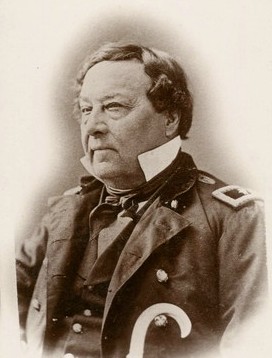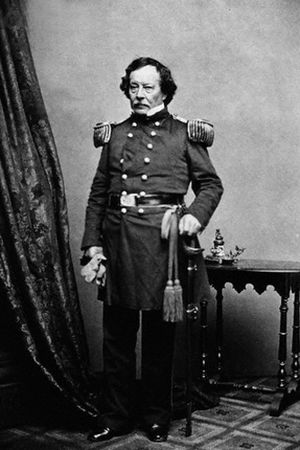Benjamin Bonneville facts for kids
Quick facts for kids
Benjamin Louis Eulalie de Bonneville
|
|
|---|---|

Benjamin Bonneville
|
|
| Born | April 14, 1796 near Paris, France |
| Died | June 12, 1878 (aged 82) Fort Smith, Arkansas, United States |
| Place of burial | |
| Allegiance | United States Union |
| Service/ |
United States Army< Union Army |
| Years of service | 1815–1861 |
| Rank | |
| Commands held | 3rd U.S. Infantry Department of New Mexico |
| Battles/wars | Mexican–American War Civil War |
Benjamin Louis Eulalie de Bonneville (born April 14, 1796 – died June 12, 1878) was an American army officer, fur trapper, and explorer. He became famous for his trips into the American West. He explored areas like the Oregon Country and the Great Basin. He also helped map parts of the famous Oregon Trail.
During his lifetime, many people learned about Bonneville's adventures. This was thanks to a book written by the famous author Washington Irving.
Contents
Who Was Benjamin Bonneville?
Benjamin Bonneville was born in or near Paris, France. His father, Nicholas Bonneville, was a publisher. When Benjamin was seven, his family moved to the United States in 1803. Their trip was paid for by Thomas Paine, a famous American writer. Paine had lived with the Bonneville family in France. He was also a godfather to Benjamin and his two brothers. When Paine died in 1809, he left most of his money and land to Benjamin's mother. This helped her take care of and educate her sons.
Becoming an Army Officer
In 1813, young Benjamin got a spot at the United States Military Academy in West Point. He finished his studies in just two years. He then became a second lieutenant in the light artillery. Early in his career, he served at army posts in New England, Mississippi, and Fort Smith in the Arkansas Territory.
By 1824, he was at Fort Gibson in the Indian Territory. He was also promoted to Captain. He even visited France and was a guest of General Lafayette. After returning, he moved to Jefferson Barracks in Missouri in 1828.
Dreaming of the West
While in Missouri, Bonneville became very interested in exploring the American West. He read about it from writers like Hall J. Kelley. He also read articles in the St. Louis Enquirer newspaper. Bonneville even met Kelley, who was impressed by him. Kelley asked Bonneville to lead an expedition to the Oregon Country. However, this trip was later canceled.
Bonneville still wanted to explore. He asked General Alexander Macomb for time off from the army. He said he could gather important information about the Native Americans in the Oregon Country. At that time, both the U.S. and Britain claimed this area. It was mostly controlled by the Hudson's Bay Company.
General Macomb agreed to his request. He gave Bonneville 26 months off, from August 1831 to October 1833. Macomb told him to collect all useful information for the government. Bonneville was to pretend to be a fur trader. He needed to learn about the region's nature, weather, soil, and geography. He also had to study the local tribes. Friends and wealthy people helped pay for his trip.
Family Life
Bonneville married and had a daughter. Sadly, both his first wife and daughter passed away. He did not marry again until after he retired from the military in 1866. He then settled in Fort Smith, Arkansas and married Sue Neis.
Exploring the Wild West
The most famous part of Bonneville's life began in May 1832. He left Missouri with 110 men. This group included explorers like Nathaniel Jarvis Wyeth and Joseph Walker. John Jacob Astor, a rich businessman, paid for the trip. Astor was a rival of the Hudson's Bay Company.
The expedition started from Fort Osage on the Missouri River. They traveled up the Platte River and across what is now Wyoming. In August, they reached the Green River. There, they built a fur trading post called Fort Bonneville. However, other explorers called it "Fort Nonsense" because it was never really used for trading.
Discoveries and Challenges
In the spring of 1833, Bonneville explored along the Snake River in Idaho. He went towards the Salmon River and eventually to Fort Nez Perce. On this trip, he hired a 10-year-old Shoshone boy named John Enos as a guide. Enos was the nephew of the famous chief Washakie.
Bonneville also sent a group of men led by Joe Walker to explore the Great Salt Lake. Walker was also told to find a land route to California. Walker found a path along the Humboldt River across Nevada. He also discovered Walker Pass through the Sierra Nevada mountains. This path later became known as the California Trail. It was a main route for people heading to the California Gold Rush. Some historians believe Bonneville might have been trying to find a way for the U.S. Army to enter California, which was then part of Mexico.
John McLoughlin was in charge of the Hudson's Bay Company's operations at Fort Vancouver. When he heard about Bonneville's mission, he told his traders not to do business with Bonneville. Bonneville reported that many Native Americans were also afraid to trade with the Americans. They did not want to upset the Hudson's Bay Company.
In the summer of 1833, Bonneville went to the Wind River Range in Wyoming. He wanted to trade with the Shoshone people. By this time, he knew he could not return east by October as planned. He wrote a long letter to General Macomb. In it, he described some of his findings and asked for more time. He especially wanted to explore the Columbia River and parts of the Southwest.
Trying to Reach Oregon
After spending the early winter at Fort Bonneville, he headed west in January 1834. His goal was to reach the Willamette Valley. He and his men traveled down the Snake River, through Hells Canyon, and into the Wallowa Mountains. There, the Nez Perces people welcomed them along the Imnaha River.
On March 4, 1834, they reached Fort Nez Perces. This was a Hudson's Bay Company outpost at the meeting point of the Walla Walla River and the Columbia River. Pierre Pambrun, the fort's commander, welcomed Bonneville. However, he refused to trade with him. With no supplies, Bonneville and his men went back to southeast Idaho. They made camp on the Portneuf River.
In July, he made a second trip west. He was determined to trade with the Hudson's Bay Company. He took an easier route across the Blue Mountains. There, he met Nathaniel Wyeth again. They camped along the Grande Ronde River. By this time, Bonneville and his men were very short on food and supplies. At Fort Nez Perces, Pambrun still refused to trade. Instead of going straight back east, Bonneville and his men traveled down the Columbia River towards Fort Vancouver. Along the river, he tried to trade with the Sahaptins, but he had no luck. He realized that John McLoughlin at Fort Vancouver would likely also refuse him. So, he decided to turn back east.
He spent the winter of 1834–35 with the Shoshone along the upper Bear River. In April 1835, he began the journey back to Missouri. He reached Independence by August. He then found out that his letter asking for more time had arrived, but it was not given to General Macomb. Because of this, his army position had been taken away.
Washington Irving's Book
Bonneville traveled east hoping to get his army position back. On his way to Washington, D.C., he stopped in New York City. There, he met his supporter, John Jacob Astor. While staying with Astor, Bonneville met the famous writer Washington Irving. Bonneville told Irving many exciting stories about his adventures. Bonneville had been planning to write a book about them.
A month or two later, Irving visited Bonneville again. Bonneville was having trouble writing his book. They agreed that for $1000, Bonneville would give Irving his maps and notes. Irving would then use them to write his own book. The result was The Adventures of Captain Bonneville, published in 1837. This book made Bonneville famous.
More Military Service
In Washington, D.C., Bonneville worked hard to get his army position back. He spoke to Secretary of War Lewis Cass. In early 1836, he succeeded! In the years that followed, he was given new assignments. He served on the western frontier at Fort Kearny in the Nebraska Territory. He also served in the New Mexico Territory at Fort Fillmore. On February 3, 1855, he became the commander of the Third Infantry Regiment.
He also fought in the Mexican–American War. He was part of the Veracruz campaign led by Winfield Scott. He also helped occupy Mexico City. In 1855, he was promoted to Colonel of the 3rd Infantry Regiment. He commanded the Department of New Mexico twice.
Bonneville retired from active service in 1861. However, he was soon called back to duty during the Civil War. From 1861 to 1863, Bonneville was in charge of recruiting soldiers in Missouri. From 1862 to 1865, he commanded Benton Barracks in St. Louis. At the end of the war, he was given the honorary rank of brigadier general. This was to honor his long and important career.
He retired a second time in 1866. He then moved to Fort Smith, Arkansas, where he married Sue Neis.
Brevet Brigadier General Bonneville died at age 82 in 1878. He is buried in Bellefontaine Cemetery in St. Louis, Missouri.
Namesakes
Many places and things are named after Benjamin Bonneville. These include:
- Booneville, Arkansas, a town
- Bonneville Avenue in Las Vegas, Nevada
- Bonneville County in Idaho
- Bonneville Salt Flats, a famous flat area of land
- Lake Bonneville, an ancient lake that existed long ago
- Bonneville Slide, a large landslide
- Bonneville Peak in the Portneuf Range
- Bonneville High School in Idaho Falls, Idaho
- Bonneville High School in Washington Terrace, Utah
- Bonneville Elementary School in Salt Lake City, Utah
- Bonneville Dam, a large dam
- Pontiac Bonneville, a type of car
- Triumph Bonneville, a type of motorcycle
- Bonneville International, a broadcasting company
- Bonneville (crater) on Mars
- SS Benjamin Bonneville, a ship from World War II
Images for kids
See also
In Spanish: Benjamin Bonneville para niños




